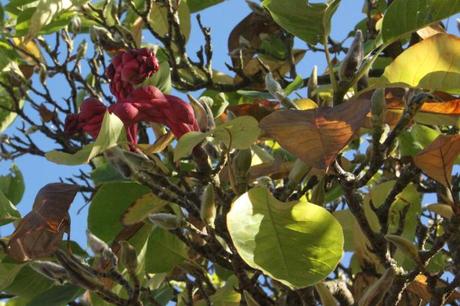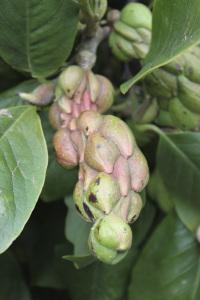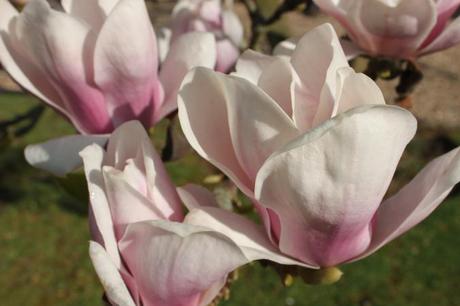Last summer three startling red seed cones appeared on our veteran Magnolia × soulangeana. A 25′ tall inherited tree which we understand was planted over 50 years ago. Sited in an exposed spot at the end of our front garden, late frosts can often leave the Magnolia blossoms as a public embarrassment. Last years long hot summer had left our tree a little drought stressed and some of the leaves were paper thin.

Magnolia October 2014
Our neighbor who has lived here as long as the tree, tells us she had never seen anything like it. On a visit to Hestercombe in October 2012 we saw a Magnolia covered in productive cones but none the color of ours last year.

Hestercombe Magnolia Seedheads October 4th 2012
Then in October 2014, Sissinghurst Garden blog and Amelia’s A French Garden posted photos of Magnolias with similar seed filled cones to ours. I wondered what had caused our Magnolia at age 50 to start producing. I googled an answer and was left confused by vague lack of pollination reports. The RHS website blurb says ” Magnolias grow readily from seed but may take over 10 years to begin flowering. Collect seedswhen the cones begin to split. Many of the seeds do not fully develop due to lack of pollination.”
This had me thinking how are Magnolias pollinated and was the lack of pollination due to the decline in Bees or is something else afoot?

Our Magnolia x soulangeana in flower April 2013
So I emailed the RHS members advisory service to ask about the pollination of Magnolias and what they thought may have caused ours to finally produce. I had paced out the position of the nearest neighbouring Magnolia and its around 400metres away from ours. Generally they thought the weather conditions – our long hot summer – and they suggested our tree had reached maturity. I emailed again to clarify the pollination and was intrigued further by their detailed response.
“Our Botanist says magnolia expert Jim Gardiner thinks that although self-pollination (ie by pollen from the same tree) is possible (primarily through the agency of beetles) magnolias are more likely to be pollinated by insects that have visited another tree. They are famously largely pollinated by beetles which are able to find a way into the unopened flowers more easily than bees, flies and other insects. The stigmas are receptive to pollen before the flowers open and quickly become unreceptive on opening. 400m is admittedly quite a large separation, but I do not think it rules out the possibility of cross pollination by another tree.”
It seems timing and ability are key if the stigmas are only receptive for a short time and the shape of the unopened flowers is best suited to beetles and not the bees I had worried about.

Magnolia Seeds
I emailed back one last time to ask if Beetles had been responsible, which species might that be. And again was further intrigued by the response from their Diagnostic Entomologist.
“Although magnolia has flowers that specialise in being pollinated by beetles, it is unlikely that that there is only a single species that does this. Beetles from 9 families have been recorded pollinating magnolia worldwide:
- Cerambycidae (Longhorn beetles, 60 UK species)
- Chrysomelidae (Seed & leaf beetles, 281 UK species)
- Curculionidae (Weevils, 480 UK Species)
- Mordellidae (Tumbling flower beetles, 17 UK species)
- Nitidulidae (Pollen beetles, 91 UK species)
- Oedemeridae (False blister beetles, 10 UK species)
- Scarabaeidae (dung beetles, 83 UK species)
- Scraptiidae (False flower beetles, 16 UK species)
- Staphylinidae (Rove beetles, 1,000 UK species)
It is likely that there are several species from the families above that are responsible for pollinating your magnolia, the exact species will probably depend on both the local beetle fauna and the identity of your magnolia.”
There is so much to learn! If it was a beetle, I know virtually nothing about the local Beetle fauna here but I know I am going to be paying far more attention in future.
Meanwhile as recommended I had cleaned the flesh from the outside of our Magnolia seeds and they’ve been in a small plastic bag with some vermiculite and potting compost at the bottom of our second fridge for the last two months. I shall sow the seed this week, the first time I have ever sown Magnolia seed and let you know if I have any germination success.
